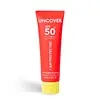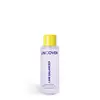What's inside
What's inside
 Key Ingredients
Key Ingredients

 Benefits
Benefits

 Concerns
Concerns

 Ingredients Side-by-side
Ingredients Side-by-side

Water
Skin ConditioningButylene Glycol
HumectantAlcohol
AntimicrobialButyloctyl Salicylate
Skin ConditioningDiethylamino Hydroxybenzoyl Hexyl Benzoate
UV FilterBis-Ethylhexyloxyphenol Methoxyphenyl Triazine
Skin ConditioningDibutyl Adipate
EmollientEthylhexyl Triazone
UV AbsorberHexyl Laurate
EmollientPolymethylsilsesquioxane
Bis-PEG/PPG-16/16 PEG/PPG-16/16 Dimethicone
EmollientCaprylyl Methicone
Skin ConditioningSodium Acrylates Crosspolymer-2
AbsorbentPolysilicone-15
UV FilterIsoamyl P-Methoxycinnamate
UV Absorber1,2-Hexanediol
Skin ConditioningPentylene Glycol
Skin ConditioningPolysorbate 60
EmulsifyingSodium Acrylate/Sodium Acryloyldimethyl Taurate Copolymer
Emulsion StabilisingPolyisobutene
Chlorella Vulgaris Extract
Skin ConditioningGlucose
HumectantCaprylic/Capric Triglyceride
MaskingSodium Polyacryloyldimethyl Taurate
Emulsion StabilisingHydroxyacetophenone
AntioxidantPanthenol
Skin ConditioningPolyacrylate Crosspolymer-6
Emulsion StabilisingFructooligosaccharides
HumectantFructose
HumectantAloe Barbadensis Leaf Extract
EmollientCaprylyl/Capryl Glucoside
CleansingSorbitan Oleate
EmulsifyingDisodium EDTA
T-Butyl Alcohol
PerfumingEthylhexylglycerin
Skin ConditioningTocopherol
AntioxidantPentaerythrityl Tetra-Di-T-Butyl Hydroxyhydrocinnamate
AntioxidantHyaluronic Acid
HumectantCitric Acid
BufferingPotassium Sorbate
PreservativeSodium Benzoate
MaskingAscorbic Acid
AntioxidantHydrolyzed Hyaluronic Acid
HumectantSodium Hyaluronate
HumectantOryza Sativa Bran
AbrasiveWater, Butylene Glycol, Alcohol, Butyloctyl Salicylate, Diethylamino Hydroxybenzoyl Hexyl Benzoate, Bis-Ethylhexyloxyphenol Methoxyphenyl Triazine, Dibutyl Adipate, Ethylhexyl Triazone, Hexyl Laurate, Polymethylsilsesquioxane, Bis-PEG/PPG-16/16 PEG/PPG-16/16 Dimethicone, Caprylyl Methicone, Sodium Acrylates Crosspolymer-2, Polysilicone-15, Isoamyl P-Methoxycinnamate, 1,2-Hexanediol, Pentylene Glycol, Polysorbate 60, Sodium Acrylate/Sodium Acryloyldimethyl Taurate Copolymer, Polyisobutene, Chlorella Vulgaris Extract, Glucose, Caprylic/Capric Triglyceride, Sodium Polyacryloyldimethyl Taurate, Hydroxyacetophenone, Panthenol, Polyacrylate Crosspolymer-6, Fructooligosaccharides, Fructose, Aloe Barbadensis Leaf Extract, Caprylyl/Capryl Glucoside, Sorbitan Oleate, Disodium EDTA, T-Butyl Alcohol, Ethylhexylglycerin, Tocopherol, Pentaerythrityl Tetra-Di-T-Butyl Hydroxyhydrocinnamate, Hyaluronic Acid, Citric Acid, Potassium Sorbate, Sodium Benzoate, Ascorbic Acid, Hydrolyzed Hyaluronic Acid, Sodium Hyaluronate, Oryza Sativa Bran
Water
Skin ConditioningPropanediol
SolventDiglycerin
HumectantGluconolactone
Skin ConditioningHydroxyethyl Urea
Humectant1,2-Hexanediol
Skin ConditioningSodium Citrate
BufferingTromethamine
BufferingPolyacrylate Crosspolymer-6
Emulsion StabilisingHydroxyethyl Acrylate/Sodium Acryloyldimethyl Taurate Copolymer
Emulsion StabilisingChlorphenesin
AntimicrobialBetaine
HumectantPolyglycerin-3
HumectantPanthenol
Skin ConditioningAllantoin
Skin ConditioningXanthan Gum
EmulsifyingLactobionic Acid
BufferingGlycerin
HumectantSorbitan Isostearate
EmulsifyingPolysorbate 60
EmulsifyingT-Butyl Alcohol
PerfumingSaccharomyces/Xylinum/Black Tea Ferment
Skin ConditioningSodium Hyaluronate Crosspolymer
HumectantHydrolyzed Glycosaminoglycans
HumectantButylene Glycol
HumectantSodium Hyaluronate
HumectantBenzyl Glycol
SolventHydrolyzed Hyaluronic Acid
HumectantAspalathus Linearis Leaf Extract
Skin ConditioningEthylhexylglycerin
Skin ConditioningHyaluronic Acid
HumectantWater, Propanediol, Diglycerin, Gluconolactone, Hydroxyethyl Urea, 1,2-Hexanediol, Sodium Citrate, Tromethamine, Polyacrylate Crosspolymer-6, Hydroxyethyl Acrylate/Sodium Acryloyldimethyl Taurate Copolymer, Chlorphenesin, Betaine, Polyglycerin-3, Panthenol, Allantoin, Xanthan Gum, Lactobionic Acid, Glycerin, Sorbitan Isostearate, Polysorbate 60, T-Butyl Alcohol, Saccharomyces/Xylinum/Black Tea Ferment, Sodium Hyaluronate Crosspolymer, Hydrolyzed Glycosaminoglycans, Butylene Glycol, Sodium Hyaluronate, Benzyl Glycol, Hydrolyzed Hyaluronic Acid, Aspalathus Linearis Leaf Extract, Ethylhexylglycerin, Hyaluronic Acid
 Reviews
Reviews

Ingredients Explained
These ingredients are found in both products.
Ingredients higher up in an ingredient list are typically present in a larger amount.
1,2-Hexanediol is a synthetic liquid and another multi-functional powerhouse.
It is a:
- Humectant, drawing moisture into the skin
- Emollient, helping to soften skin
- Solvent, dispersing and stabilizing formulas
- Preservative booster, enhancing the antimicrobial activity of other preservatives
Butylene Glycol (or BG) is used within cosmetic products for a few different reasons:
Overall, Butylene Glycol is a safe and well-rounded ingredient that works well with other ingredients.
Though this ingredient works well with most skin types, some people with sensitive skin may experience a reaction such as allergic rashes, closed comedones, or itchiness.
Learn more about Butylene GlycolEthylhexylglycerin (we can't pronounce this either) is commonly used as a preservative and skin softener. It is derived from glyceryl.
You might see Ethylhexylglycerin often paired with other preservatives such as phenoxyethanol. Ethylhexylglycerin has been found to increase the effectiveness of these other preservatives.
Hyaluronic acid is naturally found in healthy skin. It is a humectant, meaning it draws moisture to your skin.
This ingredient helps hydrate, soothe, and protect the skin.
What makes hyaluronic acid so hydrating? It has the capacity to bind or hold large amounts of water.
Fun fact: It is already naturally found in our bodies, such as the fluids of our eyes and our joints.
Studies find this ingredient to have anti-inflammatory and anti-microbial properties. This can help speed up wound-healing.
Hyaluronic acid can be irritating if the molecule has a low-molecular weight, or if the molecules are small.
One study found low-molecular weight hyaluronic acid to be pro-inflammatory, meaning some people may experience irritation. This is because our bodies use hyaluronic acid in the wound-healing process to signal to our bodies, via irritation, that something needs healing.
The same study found high-molecular weight hyaluronic acid to be anti-inflammatory.
These are some other common types of Hyaluronic Acid:
Learn more about Hyaluronic AcidHydrolyzed Hyaluronic Acid is a form of hyaluronic acid. It is created by the hydrolysis of hyaluronic acid with a high molecular weight. Once created, Hydrolyzed Hyaluronic Acid has a low molecular weight.
Low molecular weight HA has been shown to hydrate and increase elasticity of the skin. Increasing elasticity is also associated with reduction of wrinkle depth.
One study found topical low molecular weight hyaluronic acid may be considered for the treatment of rosacea in the adult population. However, we always recommend speaking with a professional about your skin concerns.
Hyaluronic acids are a humectant. This means they draw moisture from the air. Hyaluronic acids help moisturize, soothe, and protect the skin.
Read more about other common forms of hyaluronic acid:
Learn more about Hydrolyzed Hyaluronic AcidPanthenol is a common ingredient that helps hydrate and soothe the skin. It is found naturally in our skin and hair.
There are two forms of panthenol: D and L.
D-panthenol is also known as dexpanthenol. Most cosmetics use dexpanthenol or a mixture of D and L-panthenol.
Panthenol is famous due to its ability to go deeper into the skin's layers. Using this ingredient has numerous pros (and no cons):
Like hyaluronic acid, panthenol is a humectant. Humectants are able to bind and hold large amounts of water to keep skin hydrated.
This ingredient works well for wound healing. It works by increasing tissue in the wound and helps close open wounds.
Once oxidized, panthenol converts to pantothenic acid. Panthothenic acid is found in all living cells.
This ingredient is also referred to as pro-vitamin B5.
Learn more about PanthenolPolyacrylate Crosspolymer-6 is a texture enhancer and pH adjuster.
It is be used to thicken water-based products and create a gel-texture with a velvet feel.
One manufacturer claims this ingredient to have a pH range of 2-8 and to be biodegradable.
Learn more about Polyacrylate Crosspolymer-6Polysorbate 60 is used to help stabilize products. It is a surfactant and emulsifier. These properties help keep ingredients together in a product. Surfactants help reduce surface tension between ingredients with different states, such as liquids and solids. Emulsifiers help prevent oils and waters from separating.
Polysorbate 60 is sorbitol-based and created from the ethoxylation of sorbitan. Ethoxylation is a chemical reaction used to add ethylene oxide. Sorbitan is a the dehydrated version of sorbitol, a sugar found in fruits.
In this case, the 60 comes from reacting 60 units of ethylene oxide with sorbitan.
Polysorbates are commonly used in medicine and foods.
Learn more about Polysorbate 60Sodium Hyaluronate is hyaluronic acid's salt form. It is commonly derived from the sodium salt of hyaluronic acid.
Like hyaluronic acid, it is great at holding water and acts as a humectant. This makes it a great skin hydrating ingredient.
Sodium Hyaluronate is naturally occurring in our bodies and is mostly found in eye fluid and joints.
These are some other common types of Hyaluronic Acid:
Learn more about Sodium HyaluronateT-Butyl Alcohol it is most commonly used as a solvent.
At room temperature, T-Butyl Alcohol melts and has a similar smell to camphor.
This ingredient is derived from isobutane. It is the simplest form of a tertiary alcohol. Due to its chemical structure, it is more resistant to oxidation.
Some sources online claim T-Butyl Alcohol is a fatty alcohol. However, it is not considered one due to its chemical structure.
Learn more about T-Butyl AlcoholWater. It's the most common cosmetic ingredient of all. You'll usually see it at the top of ingredient lists, meaning that it makes up the largest part of the product.
So why is it so popular? Water most often acts as a solvent - this means that it helps dissolve other ingredients into the formulation.
You'll also recognize water as that liquid we all need to stay alive. If you see this, drink a glass of water. Stay hydrated!
Learn more about Water